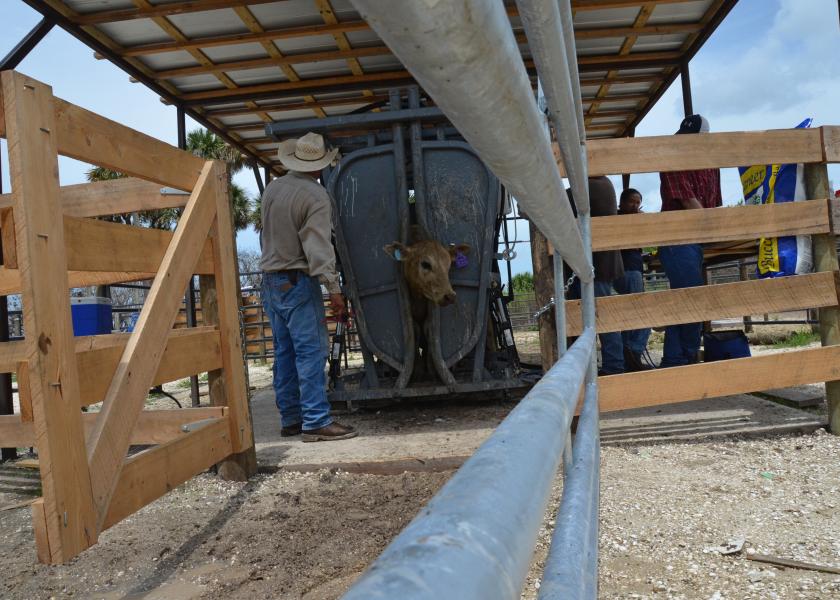Mass Treat – Still Hard to Beat, pg. 2

In addition to economics, BRD is an animal-welfare issue, and Latta encourages producers to consider animal well-being in mass-treatment decisions. “Use metaphylaxis as a tool, not a crutch,” he says.
Numerous controlled and blind trials have shown that in high-risk calves arriving at feedlots or stocker operations, mass treatment significantly reduces BRD sick pulls and mortality. However, as pressure mounts to reduce the use of antibiotics in food animals, it becomes increasingly important to understand how metaphylaxis works, and how changes in the practice might affect results.
During the AABP Conference, Brian Vander Ley, an epidemiologist at the Great Plains Veterinary Education Center, outlined his hypothesis, looking at the timing of treatment and the PMI.
Vander Ley outlined how, in BRD outbreaks, we can classify animals as either susceptible, infected or resolved/recovered. Progress of the epidemic depends on the number of effective contacts, duration of the infection and infectivity of the pathogen, modified by the proportion of susceptible and resolved hosts.
Vander Ley used a fire analogy, saying the number of contacts between hosts acts like fuel for the fire. Infectivity of the pathogen is analogous to the fuel being wet or dry, and duration corresponds with using either a match or a blowtorch to start the fire.
Calves classified as high-risk often ship from their home ranch at weaning, with unknown vaccination histories, minimal health-related management and high levels of stress, meaning a high percentage are susceptible to disease. Commingling at sale facilities and again at their destination results in a high number of contacts, or exposure to transmissible pathogens.
Metaphylaxis upon arrival, Vander Ley says, moves a high percentage of calves from the susceptible category to resolved, while also reducing transmissibility of BRD pathogens and duration of infections. This creates a sort of grace period during which the outbreak stalls. Then, during the PMI, the calves acclimate to their new environment, stress levels decline, feed intake increases and immune suppression drops off, in part due to an immune response to existing pathogens among those calves that moved from susceptible to resolved.
This concept, Vander Ley says, could help explain why prophylactic antibiotic treatment, at the ranch prior to shipping, does not match the efficacy of metaphylaxis upon arrival, following exposure during the marketing process.
With ongoing pressure to reduce antibiotic treatments and production costs, using diagnostic tools to implement more limited and targeted arrival treatments could represent the next step in receiving programs. Vander Ley outlined some of the potential benefits and challenges in incorporating diagnostics into on-arrival treatment decisions.
In theory, chute-side diagnostic tools such as blood tests, ultrasound or electronic evaluation of lung sounds can predict individual BRD risk, guide treatment decisions and possibly classify pathogens and even their sensitivity to specific antibiotics. On the downside, Vander Ley says diagnostics could slow processing speeds, add new costs and complexity and not necessarily improve clinical outcomes.
A targeted metaphylaxis program ideally would treat stressed, immune-challenged calves that are most susceptible to or infected with BRD pathogens, while not treating those already recovered from BRD, under little stress and/ or with robust immunity. In reality though, evaluating all the risk factors on individual animals presents a significant challenge.
Vander Ley notes leaving any infected calves untreated can favor reproduction and shedding of BRD pathogens and lead to outbreaks. On the other hand, treating non- infected calves could extend the risk period by leaving those animals susceptible and exposed to pathogens after the PMI.
Diagnostic tools have good potential for improving receiving program, but Vander Ley stresses that in the meantime, the industry can best address BRD risk with calf management and procurement practices designed to maximize immunity, rather than fixing earlier management deficiencies with treatments on arrival.
Related articles







